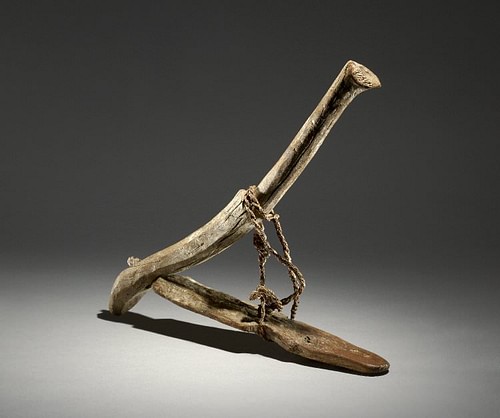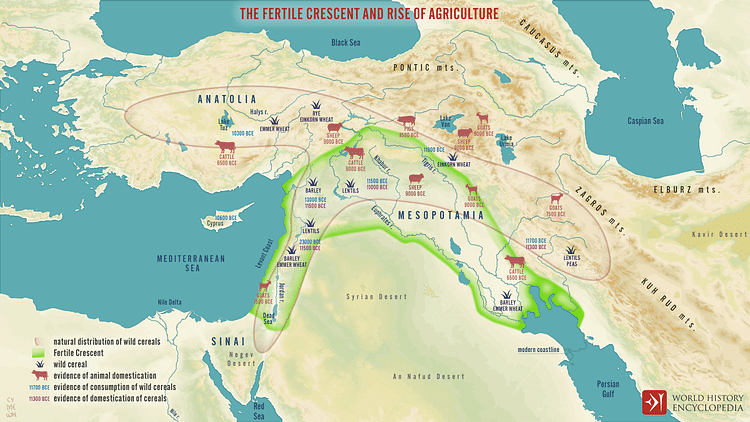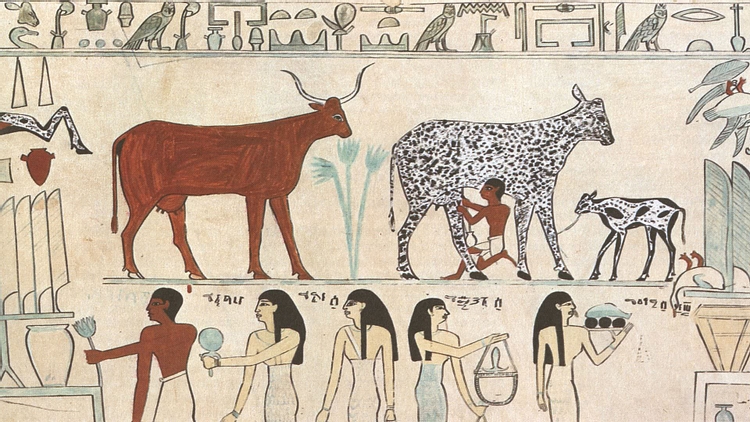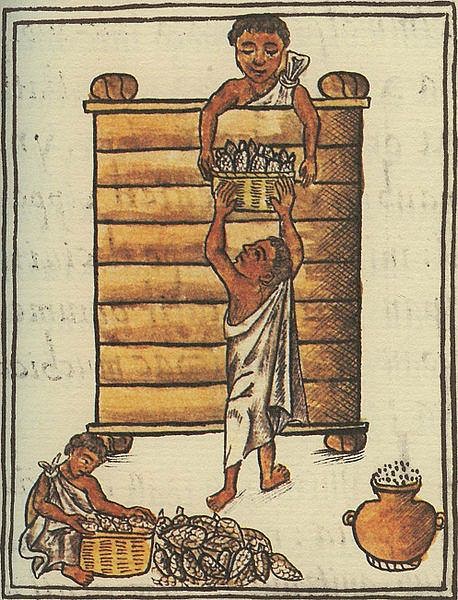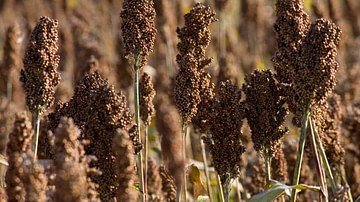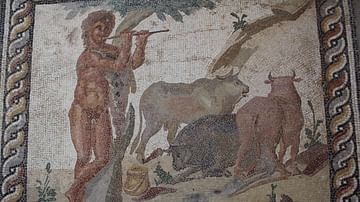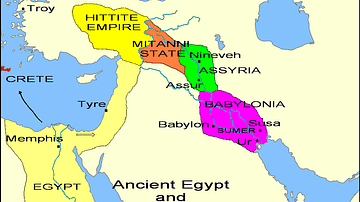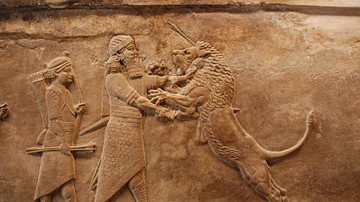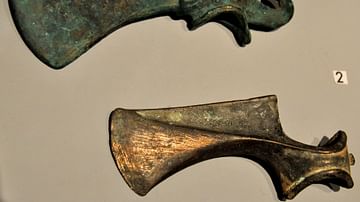Agriculture arose independently at several locations across the world, beginning about 12,000 years ago. The first crops and livestock were domesticated in six rather diffuse areas including the Near East, China, Southeast Asia, and Africa in the Old World, and Mesoamerica, South America, and Northeastern North America in the New World.
Agricultural Origins in the Old World
Farming began in the 4th millennium BCE in the hill country of southeastern Turkey, western Iran, and the Levant, where a wide range of plants and animals were located that were amenable to domestication. So many ancient agricultural sites have been located in this region that some scholars suggested that the Near East be thought of as a "nuclear area" where events at one location influenced others.
Humans began domesticating plants around 12,000 years ago. The first livestock, sheep and goats, were likely domesticated somewhere to the north and east of the heartland of plant domestication. About 11,000 years ago, barley, wheat, goats, and sheep were domesticated in the Near East, followed by pigs and cattle 10,000 years ago, peas and lentils 8,000 years ago, and olives and grapes c. 6,000 years ago.
Agriculture also began at a very early period in the forest margins of West Africa, Ethiopia, and the Sahel, the ecoclimatic transition zone between the Sahara Desert and the savanna to the south. Ethiopia has provided the earliest evidence of African farming, dating from about 6,000 years ago, but the other origins are probably just as old. The Ethiopians domesticated coffee, finger millet, and teff. People in the Sahel domesticated sorghum, pearl millet, African rice, and guinea fowl. West Africans were responsible for African yams, cowpea, watermelon, and the oil palm.
China and Asia were also early areas of plant domestication in the Old World. There is evidence that cultivation was practiced 8,000 to 10,000 years ago in Thailand and New Guinea. Two areas in China began agriculture about 8,000 years ago, the Yellow and Wei River basins in the north and the Yangtze Valley in the south. Banana, taro, citrus, and sugar cane were first domesticated in Southeast Asia, broomcorn and foxtail millet, rice, soybean, and pigs were among the early Chinese domesticates, and chickens were domesticated in an area encompassing sub-Himalayan northern India, southern China, and Southeast Asia.
| Near East | Africa | China | Southeast Asia | |
|---|---|---|---|---|
| Grains | Barley and wheat | Finger millet, pearl millet, rice, sorghum, and teff | Broomcorn millet, foxtail millet, and rice | |
| Vegetables | Chickpea, garden pea, and lentil | Yam and cowpea | Soybean | Yam and taro |
| Fruits | Date palm, fig, and grape | Watermelon | Peach | Banana and citrus |
| Oils | Olive | Oil palm | ||
|
Other |
Flax | Coffee | Tea | Sugar cane |
| Animals | Cattle, goat, pig, and sheep | Guinea fowl | Chicken and pig | Chicken |
Transcontinental Dispersal of Near Eastern Crops
Near Eastern grain culture spread rapidly, and by 8,000 years ago, Near Eastern crops had arrived in Greece, Egypt, along the Caspian Sea, and in Pakistan. Central Europe was being heavily farmed less than 1,000 years later, and by 5,000 years ago farming communities spanned the area from coastal Spain to England to Scandinavia.
Most of the founder crops of the Near East (emmer wheat, einkorn wheat, barley, lentil, pea, and flax) traveled across Europe as a group, stimulating the domestication of other crops along the way. Oats and flax began as weeds moving with the Near East assemblage but were eventually exploited and became secondary crops by the time they reached the Iberian Peninsula. Many of the vegetables that were domesticated 5,000 years ago also arose as secondary crops including the cole crops, onions, and radishes.
The spread of agriculture across the Middle East and Europe could have been due to cultural diffusion, where the new techniques were transmitted from people to people by simple learning, or by migration, where the transfer was associated with population expansion and intermating. The bulk of the evidence lends support to the migration hypothesis, by which the original stock of Near Eastern agricultural peoples was slowly diluted as their descendants moved west and mated with local peoples along the way.
Spread of Agriculture across the Mediterranean Basin
The diffusion of agriculture occurred both over the landmasses and across the Mediterranean islands.
Recent evidence suggests that the expansion of domesticates and agricultural economies across the Mediterranean was accomplished by several waves of seafaring colonists who established coastal farming enclaves around the Mediterranean Basin. (Zeder 2008)
Cyprus was colonized about 10,500 to 9,000 years ago by fully established Neolithic pioneers from the mainland. Likely traveling by boat, these colonists brought with them the full complement of the economically important mainland plants and animals, including sheep, goats, cattle, and pigs. There is also evidence of domesticated einkorn wheat, barley, emmer wheat, and lentils, as well as pistachios, flax, and figs.
This pattern of colonization played out repeatedly across the rest of the Mediterranean Basin. From the Aegean, there is strong evidence of the arrival of maritime colonists 9,000 to 8,000 years ago, who carried with them the full Neolithic package of crops. Early seafaring pioneers established farming communities in coastal Greece. The Neolithic lifeways were introduced into the Italian peninsula about 8,000 years ago by maritime colonists who first established farming villages in the Apulian "boot heel" region. Evidence of a colony of migrant farmers from mainland Italy has been found in southern France, which was settled 7,700 to 7,600 years ago.
Indian Ocean Dispersals
Indian Ocean seafarers transmitted a number of important Asian crops to Madagascar, East Africa, and India by the 2nd millennium BCE including sugar cane, citrus, Asian rice, Asian yams, taro, banana and plantain, coconut, mango, breadfruit, and possibly several spices (ginger, cloves, and cardamon). Several of these crops were then moved across the continent to West Africa including figs, sugar cane, citrus, cucumber, banana, and African rice.
At the end of the 3rd millennium BCE, an India–Gulf trading network emerged between the coastal people of southern Arabia and the Gujarati seafarers of India. Soon thereafter, five African crops were carried to South Asia: pearl millet, sorghum, cowpea, and finger millet. This crop transfer was likely between the northeast of Africa and/or Yemen and western India.
In the reverse direction from India to Africa moved Asian broomcorn millet (Panicum miliaceum), of original Chinese origin, which had begun its travels on westward trade routes by 2,200 BCE. Zebu cattle may also have been moved from India to Yemen and East Africa about this same time. The Zebu cattle subsequently hybridized with the African cattle, generating hybrids that became important to cattle pastoralists in eastern Africa.
About 5,000 years ago, several crops were domesticated in India, probably stimulated by the introduction of crops from Africa and Southeast Asia. These included eggplant, cucumber, pigeon-pea, mung bean, pepper, ginger, sesame, cotton (G. arboretum and G. herbaceum), and rice (Oryza sativa ssp. Indica).
There is also evidence of regular trade between India and the Malay Peninsula by 1,500 BCE. Mung bean (Vigna radiata) and horse gram (Macrotyloma uniflorum) were likely transferred from southern India to Southeast Asia around this time. The Southeast Asia tree crops citron and mango may also have been brought to South India from the north, with probable origins around the Assam/Burma/Yunnan area westwards to the eastern Himalayan foothills.
The banana from Indonesia likely found its way to India and Africa as early as 2,000 BCE, along with the yam (Dioscorea alata) and taro. Bananas reached western Africa by 500 BCE following forest patches and the northern fringe of the equatorial rainforest.
Chickens likely arrived in Africa from India via multiple routes. Historical linguistic data suggest three separate introductions, including two from the north across the Sahara, and one from the Indian Ocean and the east coast of Africa.
Agricultural Origins in the New World
Farming probably began independently in the New World, 1000 to 2000 years later than in the Old World. There was a relatively compact Mesoamerican center extending from today's Mexico City to Honduras, while South American crops emerged in a broad area covering most of coastal and central South America. An independent center also arose in eastern North America.
Species of amaranth, avocado, beans, chenopod, cotton, chili peppers, pumpkin, and squash were domesticated in Mesoamerica, along with maize. There were four general ecological/geographical regions of domestication in South America:
- Central mid-altitude Andes (quinoa and amaranthus)
- North and central Andes, mid-altitude and high altitude (potato, oca, and cañihua)
- Lowland southern Amazonia (cassava and peanut)
- Ecuador and northwest Peru (common beans and squash)
Turkeys were domesticated in Mexico, while llamas and guinea pigs were tamed in South America. North Americans were responsible for sunflower, sump weed, goosefoot, and probably another squash species.
| Mesoamerica | South America | North America | |
|---|---|---|---|
| Grains | Amaranthus and maize | Amaranthus, cañihua, oca & quinoa | Goosefoot, sunflower, and sump weed |
| Vegetables | Beans, chili peppers, pumpkins, squash, and tomatoes | Cassava, peanut, potato, sweet potato, and beans | Squash |
| Fruits | Avocado and agave | Guava, pineapple, and strawberry | Blueberry, cranberry, raspberry, and strawberry |
| Other | Cotton | Cotton, cocoa, tobacco, and vanilla | Tobacco |
| Animals | Turkey | Alpaca, llama, guinea pig, and muscovy duck |
Dispersal of New World Crops
From the Mesoamerican center, a maize-bean-squash assemblage gradually moved northward, picking up sunflower and numerous other native species on the way, to eastern North America, where it was well established by 4,500 years ago. Called the "Three Sisters", this assemblage displaced the indigenous crops of sump weed and chenopod. There is an ongoing debate as to whether these Mesoamerican crops diffused across the West Gulf Coast Plain or through the American south-east on the march west.
Movement south from Mesoamerica is difficult to trace for most crops, but at least maize had arrived in Central America and the Amazonian basin 5,000 to 4,000 years ago. The South American domesticates, potato, peanut lima bean, had reached north to Mexico 3,000 to 2,000 years ago, traveling through either the Caribbean islands from Venezuela or via Central America (or both).
Transcontinental Crop Exchanges – Columbian Exchange
Until about 500 years ago virtually all crop dispersals were within continents and not between them. There was spread into Oceania from Southeast Asia, but little movement occurred between the hemispheres. When Christopher Columbus arrived in the New World in 1492 CE, farmers in the two hemispheres were growing completely different assemblages of crops. There were also no large domestic animals in the Americas.
The complete homogenization of world crops did not begin until Columbus and other Spanish and Portuguese explorers brought back to Europe potato, chili pepper, and maize, originally from Mesoamerica, and tomato, beans, cassava, cocoa, and groundnuts, domesticated in South America. The European settlers tried to transfer the entire European agricultural system to the New World. In Mesoamerica, Central America, and the Andean region, the Spanish introduced barley, chickpea, cucumber, fig, and wheat, which were originally domesticated in the Near East, sugar cane and citrus from Southeast Asia, peach from China, melons from Africa, and cabbage, lettuce, grapes, and onions from the Mediterranean. In Brazil, the Portuguese introduced chickpea, fava bean, fig, and wheat from the Near East, sugar cane and banana from Southeast Asia, peach from China, sorghum from Africa, and grapes from the Mediterranean.
Today, the people of the Earth are often dependent on crops originally domesticated far from their homes. Europe and North America now rely on a hodgepodge of worldwide crops, including wheat and barley domesticated in the Near East, maize from Mesoamerica, potatoes from South America, and soybean from China. The Africans' original sorghum, millet, and yam have been largely displaced by maize from Mesoamerica, cassava and sweet potato from South America, and banana from Southeast Asia. The original Chinese crops of rice and soybean have remained important in China, but they now are grown with Mesoamerican maize and South American sweet potato and potato. In the last 500 years, world agriculture has been turned upside down.
